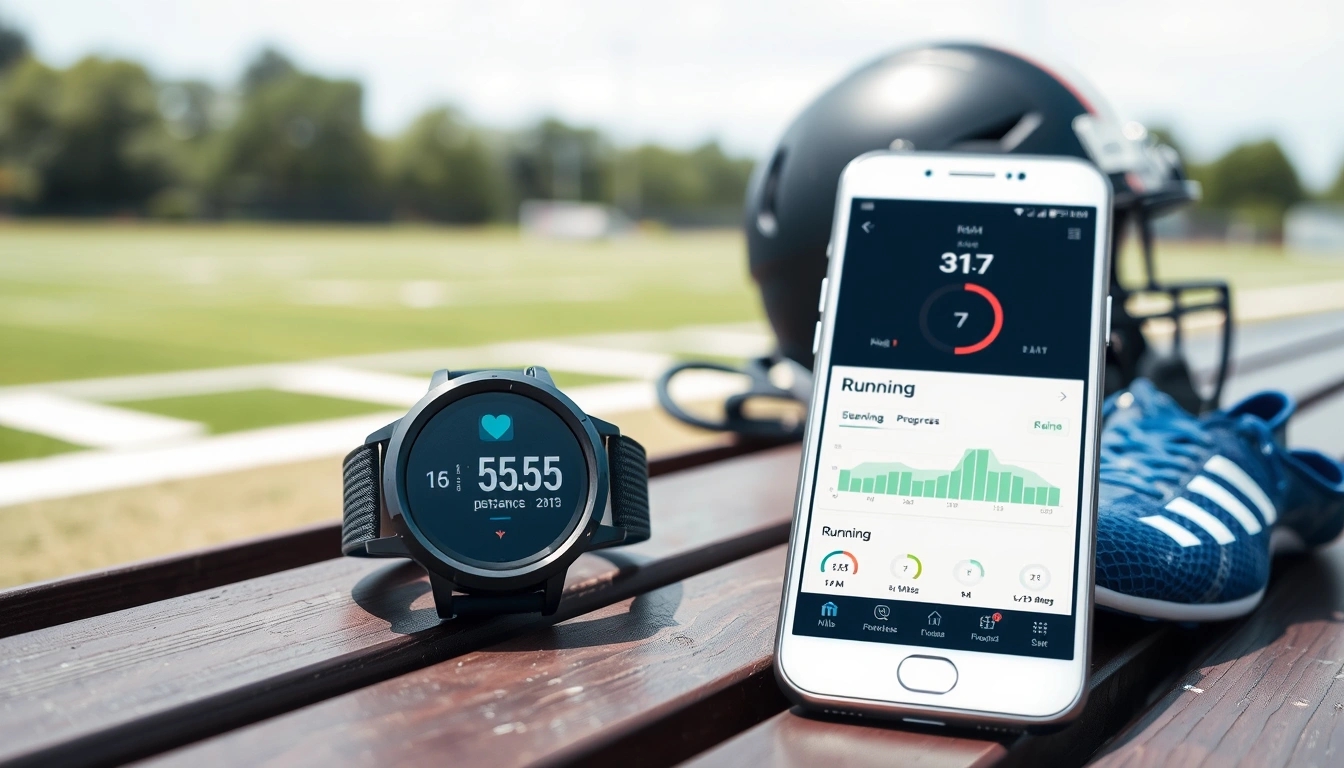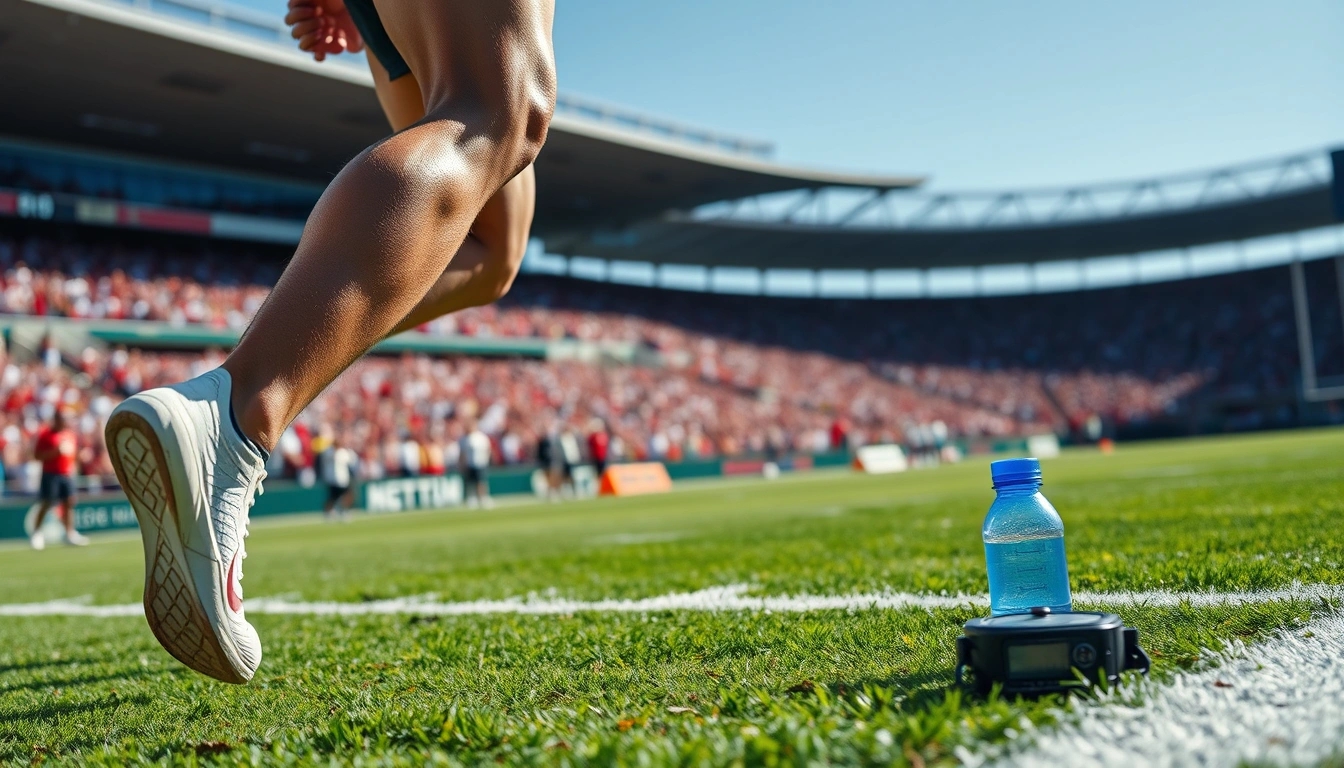Getting through a full 90-minute football match without feeling like you just sprinted a marathon isn’t some magical gift bestowed by the football gods. Nope, it’s about training smart, fueling your body right, and yeah, pushing yourself beyond what you thought possible (and sometimes what you thought sane). Endurance isn’t just running around like a headless chicken; it’s a science, a grind, and sometimes a test of patience when your legs scream, “No more!”
Understanding Football Endurance
Before you even think about hitting the pitch, you gotta understand that football endurance is a whole different beast. It’s not just jogging non-stop; it’s a mix of bursts of sprinting, quick recoveries, and constant movement. Think of it this way: your body needs to be ready for 90 minutes of stop-start action, not a steady jog. That means your muscles, lungs, and brain all need to be in sync, ready to handle explosive moves and then chill for a few seconds before the next big push.
- Explosive bursts: Sprinting after the ball, dodging defenders.
- Recovery: Slowing down, catching your breath, but staying alert.
- Consistency: Maintaining focus and energy for the entire match.
Cardiovascular Training: The Heart of Endurance
Your heart is basically the engine of your endurance machine. If it’s weak, well, good luck keeping up! Interval training is your best friend here. Mix up sprints with jogs or walks to mimic the stop-and-go rhythm of a game. Long runs? Yeah, they help build that aerobic base, but don’t get stuck only doing them. Football isn’t a marathon, it’s a rollercoaster.
| Training Type | Purpose | Example |
|---|---|---|
| Interval Training | Improve cardiovascular efficiency and recovery | 30 seconds sprint, 1 min jog, repeat 10 times |
| Long Runs | Build aerobic base | 5-7 km steady pace, 2-3 times a week |
| Fartlek Training | Simulates game intensity with random bursts | Jog for 3 mins, sprint 1 min, jog 2 mins, sprint 30 secs |
Strength Training for Stamina
Muscle isn’t just for show or looking good on the beach. Strong muscles help you power through tackles, keep your balance, and sprint without turning into a puddle of sweat by halftime. Focus on compound moves like squats, lunges, and deadlifts. Don’t forget core work! A solid core means better posture and less chance of injury.
Here’s a quick checklist for strength training:
- Squats and lunges for leg power
- Deadlifts for overall strength
- Planks and Russian twists for core stability
- Push-ups and pull-ups to balance upper body
Nutrition Tips to Fuel Your Game
You can’t outrun a bad diet, seriously. Your body needs carbs for energy, protein for muscle repair, and fats for long-term fuel. Eat a balanced meal 2-3 hours before the game — pasta, rice, or even a big sandwich works. And don’t forget hydration! Water is your best mate, but during intense training or matches, electrolytes can save your butt.
| Meal Timing | Recommended Foods | Why? |
|---|---|---|
| 2-3 hours before | Complex carbs (pasta, rice), lean protein (chicken, fish) | Slow release energy, muscle support |
| 30 minutes before | Small snack (banana, energy bar) | Quick energy boost |
| During game | Water, electrolyte drinks | Hydration and electrolyte balance |
Recovery Strategies That Actually Work
Rest isn’t just for the weak or lazy — it’s when your body actually gets stronger. Sleep is king here. Aim for 7-9 hours, no excuses. Stretching and foam rolling help keep muscles loose and less cranky. And if you really wanna be fancy, cold baths or compression gear can speed up recovery.
Mental Toughness: Endurance Beyond the Physical
Sometimes, your legs wanna quit, but your brain says, “Nope, keep going!” Building mental grit is about pushing through discomfort, staying focused, and remembering why you started playing football in the first place. Visualization, positive self-talk, and setting small goals during the match can keep you going when everything screams “stop.”
So, yeah, building endurance for 90 minutes of football is a mixed bag of physical training, nutrition, recovery, and mental grit. It’s not easy, but hey, nothing worth having ever is. Now, lace up, hit the pitch, and show that 90-minute clock who’s boss!
Understanding Football Endurance
Before you even think about tightening those laces and hitting the pitch, it’s absolutely essential to get a grip on what endurance really means in the context of football. And no, it’s not just about jogging around for 90 minutes straight like some kind of hamster on a wheel. Football endurance is a beast of its own—complex, demanding, and downright tricky to master.
Let’s break it down: endurance in football isn’t just about the ability to keep moving; it’s about sustaining high-intensity efforts repeatedly throughout the entire match. Think of it like a roller coaster ride—there are bursts of sprinting, moments of jogging, sudden stops, quick direction changes, and then some walking when you catch your breath. Your body needs to be ready for all that chaos, not just a steady jog.
- Aerobic endurance is the backbone here. This is your ability to keep going over long periods, relying primarily on oxygen to fuel your muscles.
- Anaerobic endurance is just as crucial—it’s all about those short, explosive bursts of speed and power, when your muscles work hard without enough oxygen, like during a sprint or a quick tackle.
| Type of Endurance | What It Means | Why It Matters in Football |
|---|---|---|
| Aerobic Endurance | Ability to sustain prolonged activity using oxygen | Helps maintain consistent movement, positioning, and support play |
| Anaerobic Endurance | Ability to perform high-intensity efforts without oxygen | Critical for sprints, tackles, and quick recovery between high efforts |
Now, here’s the kicker: endurance isn’t just a physical attribute. It’s a mix of physical fitness, mental toughness, and tactical intelligence. You might be the fittest player on the field, but if your brain isn’t wired to anticipate plays and conserve energy smartly, you’ll burn out faster than a cheap flare. So yeah, endurance also means pacing yourself, knowing when to push and when to chill.
Also, don’t get fooled by the idea that endurance training is just running laps until you drop. Football demands multi-directional movement, sudden stops, and explosive power. So your training should mimic that madness—think interval runs, agility drills, and strength work, not just endless jogging.
Common Misconceptions About Football Endurance:- "Just run more to get better" – Nope, quality beats quantity here.- "Endurance means no fatigue" – Fatigue is inevitable, managing it is the goal.- "Only forwards need endurance" – Every position demands it, just in different ways.
To sum it up, understanding football endurance means realizing it’s a dynamic, multifaceted challenge. It’s not about mindless running but about smart, strategic energy use combined with physical preparedness. And if you nail this concept, you’re already halfway to dominating that 90-minute grind.
Pro Tip: Next time you watch a match, pay attention to how players pace themselves. Notice the bursts, the recoveries, even the slight walks. That’s endurance in action—complex, subtle, and absolutely essential.
Cardiovascular Training: The Heart of Endurance
Alright, let’s get real for a second—your heart, or as some fancy folks call it, your “ticker,” is the true MVP when it comes to football endurance. If your heart’s not up to snuff, you’ll be sucking wind before halftime, no matter how slick your footwork is. So, why does your ticker matter so much? Because it’s the engine that pumps oxygen-rich blood to your muscles, keeping them fueled and ready to sprint, tackle, and dribble for the full 90 minutes. Without a strong cardiovascular system, you’re basically running on empty.
Now, training your heart isn’t about slogging through endless boring runs—thank goodness! It’s about working smarter, not harder, by mixing up your workouts. Intervals, long runs, and some surprisingly fun drills are the secret sauce.
- Intervals: Think of intervals as the sprint-and-recover game your heart loves. You push hard for 30 seconds to a minute, then chill out for a bit. Repeat. This keeps your heart on its toes and improves how quickly it recovers.
- Long Runs: These are the slow-burners. Running steady for 45 minutes or more builds your heart’s endurance, making it more efficient at pumping blood over extended periods.
- Fun Drills: Ever tried shuttle runs or fartlek training? These mix speed, agility, and endurance, and yes, they can actually be kinda fun. Plus, they mimic the stop-start nature of football.
Here’s a quick table to break down how each method impacts your ticker:
| Training Type | What It Does | Why It Matters |
|---|---|---|
| Intervals | Boosts heart rate variability and recovery speed | Helps you bounce back quickly during game pauses |
| Long Runs | Increases overall cardiovascular endurance | Keeps you going strong for the full match duration |
| Fun Drills (e.g., shuttle runs) | Improves agility and mimics game intensity | Prepares you for real match conditions |
But hey, don’t just run yourself into the ground. Your ticker needs rest days too, or it might throw a tantrum (and by tantrum, I mean injury or burnout). Mix in some light jogging or swimming on off days to keep things loose without overdoing it.
One last thing—don’t underestimate the power of tracking your progress. Grab a heart rate monitor or use a fitness app to see how your ticker responds over time. Seeing those numbers improve is like a shot of adrenaline for your motivation.
So, to sum it up: treat your heart like the beast it is. Train it with intervals that push and rest, take those long runs that build stamina, and throw in drills that keep the game real. Your ticker will thank you, and you’ll be the one leaving opponents in the dust come match day.

Strength Training for Stamina
Look, building muscle isn’t just about flexing in front of the mirror or showing off at the gym; it’s about having the grit to bulldoze through tackles, sprint like your life depends on it, and still have enough juice left in the tank when the clock hits 90 minutes. Football isn’t a walk in the park, and if you want to last the whole game without turning into a gasping, wheezing mess, you gotta get serious about strength training.
Now, don’t get me wrong, I’m not saying you need to become the Hulk overnight. But having a solid muscular foundation helps your body absorb those brutal hits, maintain explosive speed, and recover faster between intense bursts. When your legs feel like jelly in the last 10 minutes, it’s often because you skipped out on strength work. So, let’s break down why pumping iron (or using resistance bands, or bodyweight exercises) is your secret weapon.
- Muscle Endurance Over Bulk: Forget about looking like a bodybuilder. Focus on muscular endurance — the ability of your muscles to repeatedly exert force without tiring. Think lighter weights, higher reps, and functional moves that mimic football actions.
- Core Stability: A strong core isn’t just for Instagram pics. It stabilizes your body, improves balance, and helps you stay on your feet after those nasty tackles.
- Leg Power: Squats, lunges, and deadlifts are your best friends. They build the explosive strength that fuels those game-changing sprints and quick direction changes.
| Exercise | Sets | Reps | Focus |
|---|---|---|---|
| Squats | 3 | 12-15 | Leg power & endurance |
| Push-ups | 3 | 15-20 | Upper body strength |
| Plank (hold) | 3 | 30-60 seconds | Core stability |
| Lunges | 3 | 12 each leg | Balance & leg strength |
| Deadlifts | 3 | 10-12 | Full-body power |
But hey, don’t just mindlessly lift weights and call it a day. You gotta tailor your sessions to football’s stop-and-go chaos. That means mixing in plyometrics (jump training), explosive movements, and even some weird but effective drills like sled pushes or medicine ball throws. These help train your fast-twitch muscle fibers — the ones responsible for those lightning-fast sprints and sudden bursts of energy.
Here’s a quick tip: don’t neglect recovery. Muscles grow and get stronger when you rest, not when you’re grinding in the gym. Overdoing it will just leave you sore, tired, and more prone to injury — exactly what you don’t want mid-season. So, ice baths, foam rolling, and good ol’ fashioned sleep are your best pals.
In summary: Strength training isn’t some optional extra; it’s a must-have tool in your endurance toolbox. It’s the difference between collapsing after 60 minutes or powering through the full 90 like a champ. So, get under those weights, push yourself (but not too hard), and watch your stamina soar.
Remember: It’s not about being the biggest guy on the pitch, it’s about being the most durable and explosive. Now, go crush it!
Nutrition Tips to Fuel Your Game
Look, you can train till you’re blue in the face, but if your diet’s a mess, you’re basically running on empty. It’s like trying to power a Ferrari with cheap gas—sure, it might move, but don’t expect any speed or stamina. So, what’s the deal? What should you be stuffing your face with to last those relentless 90 minutes on the pitch? Buckle up, because this isn’t your typical “eat your veggies” spiel.
First off, timing is everything. Eating a huge meal right before kickoff? Rookie mistake. Your stomach will be busy digesting when you should be sprinting, and trust me, cramps are no fun. Aim to eat a balanced meal about 3-4 hours before the game. Think complex carbs like wholegrain pasta or brown rice, lean proteins such as chicken or fish, and a good helping of veggies. This combo fuels your muscles and keeps your blood sugar steady without the dreaded crash.
- Complex Carbs: Your main energy source. They release glucose slowly, so you don’t bonk halfway through the second half.
- Lean Protein: Helps repair muscle damage and keeps you feeling full.
- Healthy Fats: Don’t shy away from nuts, avocados, or olive oil—they’re slow-burning fuel.
Now, what about snacks? If you’re eating 90 minutes before the game, keep it light and easy to digest. A banana, a small yogurt, or a handful of nuts work wonders. Avoid anything greasy or sugary—your energy might spike, but then you’ll crash harder than a clumsy defender.
| Time Before Game | Recommended Foods | Why? |
|---|---|---|
| 3-4 hours | Wholegrain pasta, grilled chicken, steamed veggies | Provides sustained energy and muscle fuel |
| 60-90 minutes | Banana, yogurt, small handful of almonds | Quick energy without stomach discomfort |
| During game | Sports drink, water, energy gels (if needed) | Replenishes fluids and electrolytes |
Hydration? Oh, don’t get me started. You might think you’re guzzling enough water, but dehydration sneaks up like a sneaky midfielder. Start hydrating well before the match and keep sipping water or electrolyte drinks during breaks. When you’re sweating buckets, you’re losing way more than just water—you’re losing salts and minerals that keep your muscles firing. Neglect this, and cramps will come knocking.
Now, here’s a curveball—some players swear by caffeine. A cup of coffee or a caffeinated sports drink about an hour before kickoff can sharpen focus and delay fatigue. But hey, don’t go overboard; too much caffeine can make you jittery or mess with your stomach.
Quick Tips to Remember:- Don’t starve yourself before a game; your body needs fuel.- Avoid heavy, greasy foods that slow digestion.- Hydrate consistently; don’t wait until you’re thirsty.- Experiment during training to find what foods suit your gut.
At the end of the day, nutrition isn’t a one-size-fits-all deal. What works for your mate might leave you feeling sluggish. So, test out different meals and snacks during training days, not game day—unless you want to be that guy doubled over on the sidelines.
Bottom line: You can’t outrun a bad diet. Feed your body the right stuff at the right time, and you’ll be sprinting, tackling, and scoring like you’ve got a secret weapon. Your energy tank will thank you, and so will your teammates.
Recovery Strategies That Actually Work
Look, if you think rest is just for the lazy or the weak, you’re missing the whole point of playing football at a high level. Recovery isn’t some optional luxury—it’s the secret sauce that keeps you sprinting, tackling, and dribbling for a full 90 minutes without turning into a puddle of sweat and exhaustion. Seriously, neglecting recovery is like trying to run a marathon on an empty tank. You’re just asking for trouble.
Let’s get real: sleep is king here. You might think you can skate by on 5 or 6 hours, but your body screams for at least 7-9 hours to repair muscles, consolidate memory (hello, tactics!), and reset your energy systems. And don’t just crash on the couch with your phone blasting TikTok. Quality matters. Dark room, cool temperature, no distractions—that’s the dream setup. If you’re skimping on this, your endurance gains are basically on hold.
| Recovery Method | Why It Works | How to Do It |
|---|---|---|
| Sleep | Muscle repair, hormone regulation, mental reset | 7-9 hours, dark room, consistent schedule |
| Stretching | Prevents injury, reduces muscle tightness | Dynamic before training, static after |
| Hydration | Replaces lost fluids, aids nutrient transport | Drink water consistently, add electrolytes if needed |
| Foam Rolling | Loosens tight muscles, improves blood flow | Roll major muscle groups 10-15 mins post-exercise |
Now, stretching is another underrated hero in recovery. I’m not talking about half-hearted toe touches before the game. Dynamic stretching—think leg swings, lunges, arm circles—gets your blood pumping and muscles primed. After training or matches, static stretches help ease tension and improve flexibility. Trust me, those hamstrings and quads will thank you later. And if you’re skipping this, you’re basically inviting cramps and stiffness to join the party.
- Pro tip: Incorporate a cool-down walk or light jog post-match to gradually lower your heart rate.
- Bonus hack: Try contrast showers—alternating hot and cold water—to boost circulation and reduce soreness.
Hydration? Oh boy, this one’s a classic mistake. You don’t just guzzle water when you’re parched. Your body needs a steady supply throughout the day, especially after sweating buckets on the pitch. Dehydration can tank your endurance faster than you can say “penalty kick.” Electrolytes like sodium and potassium are equally crucial since they keep muscles firing properly.
And if you’re really serious about recovery, foam rolling is a game changer. It’s like giving your muscles a deep tissue massage without the hefty price tag. Rolling out tight spots helps flush toxins and improve blood flow, which speeds up healing. Aim for 10-15 minutes focusing on calves, quads, hamstrings, and your lower back. Warning: it can hurt a bit, but that’s just the stubborn knots screaming.
Quick Recovery Checklist:- Prioritize 7-9 hours of quality sleep nightly- Warm up with dynamic stretches before training- Cool down with static stretches and light jogging- Stay hydrated all day, not just during exercise- Use foam rolling regularly to ease muscle tension- Experiment with contrast showers for circulation boost
At the end of the day, recovery isn’t a chore—it’s your secret weapon. Skip it, and you’re setting yourself up for burnout, injuries, and a whole lot of frustration. Nail it, and you’ll feel fresher, faster, and more ready to crush those 90 minutes every single time. So next time you think about skipping that nap or ignoring your sore muscles, remember: champions rest hard.

Mental Toughness: Endurance Beyond the Physical
Look, anyone can lace up their boots and run till they drop, but staying sharp when your legs scream “no more” — that’s a whole different ball game. Mental toughness? It’s the secret sauce every footballer needs to last the full 90 minutes without turning into a puddle on the pitch. And no, it’s not some mystical power reserved for pros or those born with a silver whistle. It’s something you build, grind for, and sometimes wrestle with in your own head.
First off, what is mental toughness anyway? It’s that stubborn voice inside that tells you to keep pushing when your body’s begging for mercy. It’s about focus, resilience, and a pinch of stubbornness. When the clock’s ticking down and your energy’s tank is flashing empty, mental grit is what keeps you chasing the ball, making that last tackle, or sprinting for that crucial pass.
- Visualize success: Imagine yourself nailing that perfect shot or intercepting a pass when you’re dead tired. This mental rehearsal can actually prep your brain to handle pressure better.
- Chunk the game: Instead of thinking “90 minutes,” break it down. Focus on surviving the next 10, then the next. It makes the whole ordeal less daunting.
- Positive self-talk: We all have that annoying inner critic. Train yourself to swap “I’m done” with “Just one more play.” It’s cheesy but effective.
Now, here’s a quick table summarizing some mental strategies to keep your head in the game:
| Strategy | What It Does | How to Practice |
|---|---|---|
| Visualization | Prepares the brain for success | Spend 5 minutes daily imagining game scenarios |
| Goal Chunking | Makes long games feel manageable | Set mini-goals during matches (e.g. focus on next 10 minutes) |
| Positive Self-Talk | Boosts confidence and reduces stress | Replace negative thoughts with encouraging phrases |
But hey, don’t think it’s all about mind games. Mental endurance can be bolstered by physical habits too. Ever noticed how when you’re exhausted, your brain feels foggy? That’s because the body and mind are tight buddies. So, getting enough sleep, staying hydrated, and fueling your body properly can dramatically improve your mental stamina. It’s like giving your brain the premium fuel it deserves.
Here’s a quick checklist to keep your mental game strong alongside your physical training:
- Sleep at least 7-8 hours a night — no excuses, even if Netflix calls your name.
- Practice mindfulness or breathing exercises to calm nerves before and during matches.
- Reflect on tough moments after games — what worked, what didn’t? Learning from setbacks is key.
To wrap it up, building mental toughness isn’t about flipping a switch; it’s a slow burn. You’ll have days when your mind throws in the towel before your legs do. That’s normal. The trick is to keep showing up, even when it feels like your brain’s on strike. So next time fatigue hits, remind yourself: the real endurance test is what’s going on upstairs. And trust me, with a little mental muscle, you’ll outlast more than just your opponents.
Keep grinding, keep believing, and watch your mental toughness turn into your secret weapon on the pitch.
Common Mistakes to Avoid in Endurance Training
Look, endurance training sounds straightforward—run more, push harder, repeat. But if you think that’s all there is, you’re setting yourself up for a world of pain and disappointment. Trust me, I’ve seen it all: players who start off like rockets and end up flatlining way before the final whistle. So, before you lace up and hit the track or pitch, let’s talk about some classic blunders that can totally wreck your progress and leave you gasping on the sidelines.
1. Going Too Hard, Too Fast
One of the biggest rookie mistakes is trying to do too much too soon. You’re pumped, you’re motivated, but your body isn’t ready for that monster session right out of the gate. This isn’t a sprint (well, it is, but not *all* the time). Overtraining leads to burnout, injuries, and a serious case of “I can’t even.” Slow and steady wins the race here. Build up your mileage and intensity gradually—think of it like leveling up in a game, not jumping straight to the final boss.
2. Neglecting Recovery
Rest days are not a sign of weakness. They’re your secret weapon. Without proper recovery, your muscles don’t repair, your energy tanks don’t refill, and your progress stalls. Skipping rest is like trying to fill a bucket with a hole in it. Stretching, foam rolling, quality sleep, and even light activity on off days can make a huge difference.
| Recovery Tips | Why They Matter |
|---|---|
| Sleep 7-9 hours nightly | Muscle repair and mental reset |
| Active recovery (light jogging, cycling) | Boosts blood flow, reduces stiffness |
| Stretching & foam rolling | Prevents tightness and injury |
3. Ignoring Nutrition
You can’t fuel a high-performance engine with junk. Skipping meals, ignoring carbs before a big session, or just winging it with random snacks is a fast track to running on empty. Your body needs the right balance of carbs, proteins, and fats to sustain those long runs and explosive sprints. Pro tip: don’t wait until you’re starving to eat. Plan your meals and snacks around your training schedule.
4. Sticking to One Type of Training
Endurance isn’t just about running laps endlessly. If your training plan looks like a one-trick pony, you’re missing out. Mixing it up with interval training, hill sprints, strength work, and even cross-training keeps your body guessing and improves overall fitness. Plus, it’s way less boring.
- Interval Training: Boosts cardiovascular capacity and speed.
- Strength Training: Builds muscle endurance and power.
- Cross-Training: Reduces injury risk and improves recovery.
5. Forgetting Mental Preparation
Endurance is as much a head game as a physical one. If you’re not mentally ready to push through fatigue and discomfort, your body will tap out early. Visualization, goal-setting, and even simple self-talk can be surprisingly effective tools to keep you going when your legs scream “stop.”
So, before you dive headfirst into your next endurance session, take a breath and check your approach. Avoid these pitfalls, and you’ll be more likely to finish strong—not just start strong. Remember, building endurance is a marathon, not a sprint (okay, sometimes it’s both). Patience, smart training, and a bit of grit will get you through those 90 minutes and beyond.
Sample Weekly Training Plan
Alright, let’s cut through the fluff and get down to brass tacks. If you want to survive a full 90-minute football match without turning into a wheezing mess on the sidelines, you need a schedule that’s straightforward, practical, and—most importantly—keeps your sanity intact. No fancy jargon, no over-the-top workouts that leave you crawling for a week. Just a solid plan that balances cardio, strength, and rest like a pro.
- Monday: Cardio Intervals – Kickstart the week with high-intensity interval training (HIIT). Think 30 seconds sprint, 90 seconds jog, repeat for 20-30 minutes. It’s brutal but effective. Your heart will hate you, but your endurance will thank you later.
- Tuesday: Strength Training – Focus on compound lifts like squats, deadlifts, and bench presses. These bad boys build the muscle power you need to bulldoze through tackles and sprint with authority. Aim for 3 sets of 8-12 reps. Don’t forget proper form or you’ll be nursing injuries instead of scoring goals.
- Wednesday: Recovery & Mobility – Yes, rest days are sacred. But don’t just veg out on the couch. Light stretching, foam rolling, and maybe a gentle swim or yoga session to keep the muscles loose. Your body needs this if you want to avoid turning into a stiff robot by Thursday.
- Thursday: Endurance Run – Time to hit the pavement or track for a steady 40-60 minute run at a comfortable pace. This builds that aerobic base footballers swear by. No sprinting here, just steady, consistent effort.
- Friday: Strength & Power – Similar to Tuesday but add some explosive moves like jump squats, box jumps, or kettlebell swings. These drills mimic the bursts of speed and power you’ll need on the pitch. Keep it sharp, keep it snappy.
- Saturday: Tactical Practice or Light Cardio – If you have team practice, great. If not, a light jog or cycling session for 20-30 minutes to keep the legs fresh without burning out. Maybe throw in some ball drills if you’re feeling fancy.
- Sunday: Full Rest – No excuses. Sleep in, binge-watch your favorite show, eat whatever you want (within reason), and let your body hit the reset button. You’ve earned it.
| Day | Focus | Duration | Notes |
|---|---|---|---|
| Monday | HIIT Cardio | 20-30 mins | Short sprints with recovery jogs |
| Tuesday | Strength Training | 45-60 mins | Compound lifts & proper form |
| Wednesday | Recovery & Mobility | 30 mins | Stretching & foam rolling |
| Thursday | Endurance Run | 40-60 mins | Steady pace, aerobic focus |
| Friday | Strength & Power | 45-60 mins | Explosive movements |
| Saturday | Tactical Practice / Light Cardio | 20-30 mins | Ball drills or light jog |
| Sunday | Full Rest | All day | Recharge & relax |
Now, before you start thinking this is some rigid, boring schedule, remember: flexibility is key. Feel like you need an extra rest day? Take it. Missed a session? Don’t sweat it, just get back on track. The goal here isn’t to become a workout robot but to build sustainable endurance that lasts through those grueling 90 minutes.
One last nugget of wisdom: consistency beats intensity. You’re better off doing moderate workouts regularly than going full beast mode once and burning out. Stick to this plan, listen to your body, and watch your stamina soar. Your lungs, legs, and teammates will thank you.
Pro tip: Keep a training journal or use a simple app to track how you feel after each session. It’s surprisingly motivating to see progress—even on days you think you’re dragging.
So, lace up, show up, and let this no-nonsense plan guide you to football endurance glory. You’ve got this.

Tracking Progress: Tools and Tips
Alright, so you’ve been grinding away at your endurance training, sweating buckets, and maybe even cursing your own name during those brutal runs. But how do you actually know if you’re getting better? Just hoping you feel less tired isn’t the best strategy—though hey, sometimes that’s all we got. Luckily, there are plenty of ways to track your endurance gains, from fancy gadgets to good old-fashioned self-checks. Let’s break it down, no fluff.
- Wearable Tech: Smartwatches and fitness trackers have exploded in popularity, and for good reason. Devices like the Garmin Forerunner, Fitbit, or Apple Watch can monitor your heart rate, track your distance, pace, and even estimate VO2 max (that’s a fancy term for how efficiently your body uses oxygen). These stats give you a quantifiable look at your progress. If your resting heart rate drops or your pace improves over the same distance, you’re on the right track.
- Apps to the Rescue: Apps like Strava, MapMyRun, or Nike Run Club don’t just log your runs; they create a community, set challenges, and offer insights. Plus, they let you compare performances over time, so you can see if that 5k you dreaded last month feels easier now. Some apps even analyze your running form or suggest training plans tailored to your goals.
Now, if you’re thinking, “Hey, I don’t need gadgets to tell me I’m tired or not,” you’re not wrong. Sometimes, the best tool is your own body and a bit of honest self-assessment. Here’s how:
| Self-Assessment Method | How It Works | Why Use It |
|---|---|---|
| Talk Test | Try talking during exercise. If you can chat comfortably, your endurance is solid. If you’re gasping for air, you’re pushing too hard. | Simple, no equipment needed, and great for pacing yourself during training or games. |
| Rate of Perceived Exertion (RPE) | On a scale of 1-10, rate how hard your body feels during activity. | Helps you tune into your effort and avoid burnout or undertraining. |
| Recovery Time Check | Measure how quickly your heart rate returns to normal after intense effort. | Faster recovery usually means better cardiovascular fitness. |
And hey, don’t forget to jot down your feelings and results in a training journal or app. It’s not just about numbers; tracking your mood, energy levels, and sleep quality can reveal patterns that impact your endurance.
One last nugget of wisdom: consistency trumps perfection. Don’t obsess over every single metric or get discouraged if the gadgets tell you your progress is slow. Endurance takes time, and sometimes it’s about those small wins—like finishing a session without wanting to collapse or feeling less wiped out after a game.
So, whether you’re a tech junkie or a “feel the burn” kind of player, mixing gadgets, apps, and self-assessment is the sweet spot for staying motivated and on track. Now, get out there and show that 90-minute football match who’s boss!
Frequently Asked Questions (The title must be written in English.)
- How long does it take to build enough endurance for a full 90-minute football match?
Building solid endurance is like planting a tree—it doesn’t happen overnight. Typically, with consistent training combining cardio, strength, and recovery, you can notice significant improvements within 6 to 8 weeks. Remember, it’s about gradual progress, not sprinting to the finish line too fast!
- What types of cardio exercises are best for football endurance?
Think of your heart as the engine of a race car; it needs varied workouts to perform at its peak. Interval training (short bursts of intense activity followed by rest), long steady runs, and agility drills are fantastic. Mixing these keeps your body guessing and builds the stamina you need to last the full game.
- Is strength training really necessary for football endurance?
Absolutely! Strength training is like adding turbo boost to your game. It helps your muscles resist fatigue, recover faster, and power through tackles and sprints. Incorporate exercises focusing on legs, core, and upper body to build balanced stamina that supports your endurance.
- What should I eat before and during a match to maintain energy?
Fueling your body is like topping up your gas tank. Eat a balanced meal rich in complex carbs and lean protein about 2-3 hours before the match. During the game, quick carbs like fruit or energy gels can keep your energy levels from dipping. Hydration is just as crucial—never underestimate the power of water!
- How important is recovery in endurance training?
Think of recovery as the secret sauce that makes all your hard work stick. Without proper rest, your muscles can’t repair, and your performance dips. Prioritize quality sleep, stretching, and active recovery days to keep your endurance climbing, not crashing.
- Can mental toughness really affect my endurance on the field?
Definitely! Endurance isn’t just physical; it’s a mental marathon too. Building mental toughness helps you push through fatigue and stay focused when your body screams “stop.” Techniques like visualization, goal setting, and positive self-talk can turn you into a relentless competitor.
- What are common mistakes to avoid when training for football endurance?
One big trap is overtraining—pushing too hard without enough rest can lead to burnout or injury. Another is neglecting nutrition or hydration, which can sabotage your stamina. Lastly, skipping strength training or mental prep means you’re only half-ready for the demands of a full match.
- How can I track my endurance progress effectively?
Tracking progress is like having a GPS for your fitness journey. Use apps or fitness trackers to monitor your heart rate, distance covered, and recovery times. Don’t forget the old-school method: how you feel during and after training is a powerful indicator of your endurance gains.












